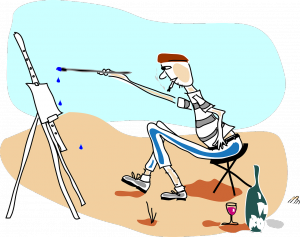Tips for Painting with Oils That Will Make Your Life a Little Easier – And, Less Messy!
Hey there, fellow artists! Since I’ve been painting and drawing all my life, I thought I’d write down a few things I’ve learned from experience…
So, whether you’re just beginning at oil painting or not, maybe there’s a few things you’ll find helpful to both shorten the time it takes to get started on a painting, and to clean up a bit easier when you’re done for the day.
Who knows? You might be able to save some dollars while you’re at it too.
Oil Painting Tips
- Clean dry rags – always have a few of these handy to clean your brushes, wipe off excess paint, and to use for those little oops that occur while painting. You can wipe off any mistakes that you make as long as the paint is still wet…just make sure the rag is clean first. I use old t-shirts or any kind of material that isn’t too linty…and they last a long time, so you don’t have to continually buy paper towel.
- Make a plan before you paint – plan out what colors you will be using first and get them ready on your palette before you start painting. Otherwise, it’s a pain in the…opening a tube of paint every time you need another color and having to mix it with whatever medium you plan on using. Add the colors you plan on using to the outer areas of your palette and mix any shades you need in the center, keeping enough room between colors so they don’t end up getting mixed up together. It also helps to keep your paint ranging from lightest to darkest or vice versa…that way you’re not searching around so much for that next shade you want to add.
- Disposable Gloves – I find these work wonders in avoiding a big mess…ever opened an oil paint tube before? It can be a downright mess! I’ve even had the tube crack when trying to open some of them and I really wish I had known to use disposable gloves at that time. I don’t use them the whole time I’m painting, but when it comes to getting those tubes open, mixing up the paint, cleaning the brushes, and whatever other mess I’ve made, they save a lot of time and misery.
- Old Cooking Oil – you can use your old cooking oil to “clean” the oil paint off of your hands if you do get any paint on them. I usually save any “old” or used cooking oil that I can from our fryer in an empty cooking oil bottle just for this purpose. I also label the bottle and keep it with my art supplies so no one uses it for cooking or throws it out. I’ve found it to be very effective at cleaning off oil paint from hands, a bit greasy feeling, but if it’s safe enough to use for food it should be safe enough to use on your hands. Pour just a tiny bit on your hands, about the size of a quarter, while you’re at the sink and wash your hands with the oil. Then use plain old dish soap to wash them again to get the greasy feel off…works like a charm and it’s free as long as you save your old oil! Oh, and one thing is do NOT use it to clean your brushes though…it works for awhile, but eventually the brushes get gummed up and the bristles stiffen up as hard as rocks…at least that’s what happened to my old brushes when I tried it.
- Wear a Painting Shirt – any old shirt will do! If you’re like me, somehow you’ll end up wearing the oil paint, especially on your shirt. It’s only a matter of time, no matter how careful you are you’ll end up with paint on your clothes…even your hair sometimes! Not that I’d know anything about that… 🙂 I did have some spiffy red highlights in my hair for awhile though…
- Drawing the Outline – If you’re painting something that requires things to be in a certain place and you need some kind of guide to go by as you paint, then draw in an outline before you start. You can use an HB pencil, which is what I’ve used in the past, or else a thin paint to add an outline and even block in some of the areas of shadow and light. If using a pencil, draw lightly and avoid erasing if at all possible…using a regular eraser might leave smudges on the canvas that won’t come off, although a kneaded eraser might work to pull up pencil marks. You can also draw your outline on paper first, and then trace it onto the canvas, by either using carbon paper or by coloring in the back of your drawing with pencil and then tracing over the outline with a ball point pen.
- Fat Over Lean Rule of Oil Painting – Never paint with lean (less oil or thin) paint over fat paint (paint which has more oil in it). As the oil paint in the bottom layers continues to dry, it absorbs the oil from the top layers, so if the layer of paint on the top is already dry, it’ll crack if there’s too little oil in it. This is the reason for increasing the amount of oil used in each layer as you go, not just to make the paint more transparent. Just remember, begin with the fastest drying and work towards the slowest drying as you paint each layer.
- Old Paper Grocery Bags – you can use them for painting! No, I don’t mean paint on an old paper bag…(of course, if you really want to… go ahead!) what I mean is use any old paper grocery bags you have laying around under your easel to catch any drips, spills, and dropped brushes full of paint…no, I never did that one! Another couple of things I find them handy for is testing out my paint mixtures to see how opaque or transparent the paint is before adding it to my canvas and also to wipe any excess paint from my brush on since it’s right there… at least when I’m using the small tabletop easel it’s right there under my easel where I can find it without even looking…it’s been a nice time saver and table saver!
Well, that’s about it for now…if I think of more I’ll add them in an update.
Do you have any oil painting tips, techniques, or stories you’d like to share? I’d love to hear them! Just leave a comment in the box below…
Thank you for reading, and I hope you found this helpful one way or another…
If so, please do me a favor? Please, share it if you like it, or found it helpful in some way. I’d appreciate it!
Either way, thanks again and best wishes 🙂 -Sherry


Very interesting, I never knew about oil paints and how they crack if they lose oil from the under layer sucking the oil out. So, never painting lean is a great tip and probably something that happens to amateurs frequently.
I like the idea of disposable gloves as that would save tons of time not having to clean an oily mess off your hands after every time you get things set up and ready for painting.
I also like the ideas of using old cooking oil, I don’t deep fry things really but I will maybe try coconut oil as it’s also really good for your skin.
I will have to always remember these tips for painting with oils for the future as my wife and I tried to paint a little for a hobby and used just water based colors, I think….I’m not sure why oils were used and I’m guessing it looks better, as it seems like a bigger hassle to paint with. Do you think oil paints are for a more skilled painter?
Great Article Thanks,
Brandon
Hi Brandon,
Yes, the top layers begin to crack if they’re layered over paint that has too much oil or is too “fat.” That’s why it’s important to keep the first bottom layers lean or with as little oil as possible. As long as the oil is gradually added a little more for each layer as you go, it should be fine.
Unfortunately, cracking probably does happen a lot to those that haven’t heard of the fat over lean rule…I didn’t know of it either until a few years ago. Thankfully, this hasn’t happened to any of my paintings yet, so I must have done something right, lol.
Another thing I should mention is many painter’s choose to paint with the “wet on wet” technique, so it’s not too much of a problem then since all the painting is done while it’s still wet. Painting “wet on wet” doesn’t get quite the same effect as the classic or Flemish technique though. I suppose it’s all up to the person seeing the painting on what looks better…you know how the old saying goes, “beauty is in the eye of the beholder.”
Well, yeah, painting with oils can be a bit of hassle especially when it comes to the cleaning up part, but I really love it. It has a different texture or feel to it while you’re painting…I guess what I’m trying to say is I like it since to me, it’s easier to control where it goes and I can add as tiny a detail as I want.
But, painting with something like water colors is a different story, at least the few times I tried it. I had it running everywhere! And, to me, it looked like a complete mess. I’d say give them all a try first…watercolor, acrylic, and oil to see which one you feel most comfortable using.
I’m happy to hear you like the ideas of using disposable gloves and cooking oil. It does save a lot of time and so much scrubbing on the poor old hands! I’d never thought of using coconut oil, but I’m pretty sure that would work too. I’ll have to try it sometime since it is good for the skin.
Thank you for stopping by and commenting. I do hope it helps you and your wife the next time you’re painting…feel free to stop by again sometime!
Best wishes ~Sherry